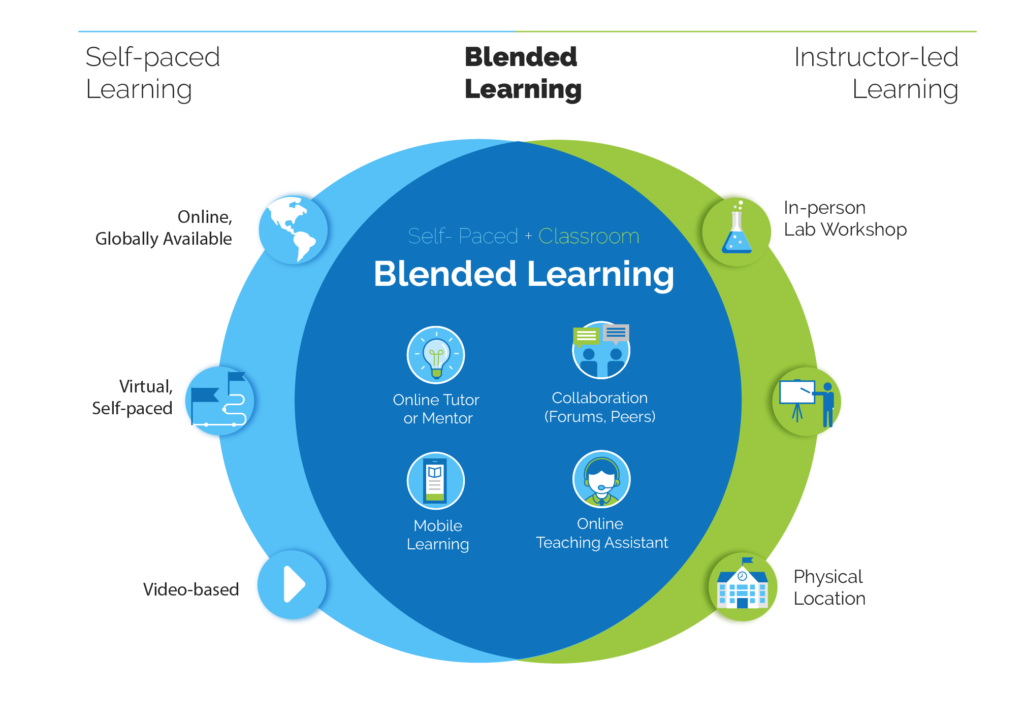The world of higher education is constantly in flux. Best practices are ever-evolving, as are student expectations and personalities. Meeting these changing needs is no small feat, especially for large institutions who are concerned with budgetary, staffing, and infrastructure constraints.
One creative solution is to employ a blended learning framework that utilizes both classroom-based and online coursework to engage students and improve learning outcomes.
How does blended learning empower students?
Traditional classroom instructor-led models have the benefit of providing structure and guidance, but can feel restrictive to students. Some subjects may even feel like a waste of time, depending on student interests and goals. On the other hand, student-led learning allows them to explore on their own terms, as well as to customize an education plan. But without the structure and support of an educator, many students become lost and frustrated by the process. They also miss the interaction and natural learning that comes from working alongside peers. These models are often employed independently of one another, and not always with ideal results.
By combining these approaches, students can experience a structured environment with the support they need, while still being able to design a program to meet their learning goals and schedules. The result is a more engaged student who feels ownership over their learning, while still receiving the guidance and personal interaction many require to stay on track.

What to consider in a modern learning environment
With the vast access to information the Internet provides, student expectations have shifted. They are looking for more flexible and creative learning environments, including:
Flexible approaches to learning The ability to take classes online or in person, and to engage in learning in newer ways such as webinars, video lectures, and interactive virtual lessons.
A curriculum that offers future-ready skills Students want to stay relevant in a rapidly evolving world and are looking for forward-facing curriculum that will meet their future needs as they move on to careers and entrepreneurial pursuits.
An infrastructure that supports multiple learning styles Utilizing a combination of elements, such as video, audio books, animations, and even interactive elements and games will appeal to a wider variety of students than traditional textbooks.
Ability to interact with their peers In addition to in-person engagement, students want to connect with peers through community forums, video chats, messaging systems, etc.
Communication with an instructor when needed To provide the necessary flexibility, instructors can employ virtual office hours, email, forum discussions, and video calls and webinars to connect with students beyond classroom-based interaction.
A device-agnostic learning environment As technology has shifted from mere tool to lifestyle accessory, so have student expectations shifted to an expectation of freedom to choose their own learning devices. Any virtual learning should be accessible across devices, including on mobile.

5 steps toward a more engaged blended learning environment
While implementation of a blended learning framework may seem overwhelming, it doesn’t need to be. These five steps aren’t trivial, but they will help pave the way for a modern and flexible academic institution.
- Re-design curriculum for future-ready skills and re-align it to learner needs – This is an ongoing process, but take another look at the curriculum and update it as necessary. Taking a modular approach to designing curriculum can help with updates over time.
- Utilize Massive Open Online Courses, or MOOCs, which are online courses available to learners worldwide for little or no cost – MOOCs allow you to meet the needs of a large number of learners without the same staffing and infrastructure expenses as traditional coursework.
- Embed multiple ways of engaging learners within the curriculum to support multiple learning styles – As mentioned above, translate curriculum elements into mixed media platforms such as video, games, and audio books.
- Embrace cloud technology that supports a blended learning framework – Cloud technology can remove some of the burden of your local network infrastructure, while also minimizing IT concerns. It will help you provide stable, on-demand access to your learning content to students around the world.
- Find a way to implement a modern learning framework that can reside on top of the existing technology infrastructure – There is no need to reinvent the wheel. Make the best use of the infrastructure you already have to serve your updated content to students.

As society continues to shift expectations and demands on the higher education system, academic institutions will need to be nimble in response. Implementing blended learning allows for reaching a broader collection of students, while empowering them to take charge of their learning. Those who can rise to this challenge will certainly hold a great advantage as things continue to quickly evolve.


